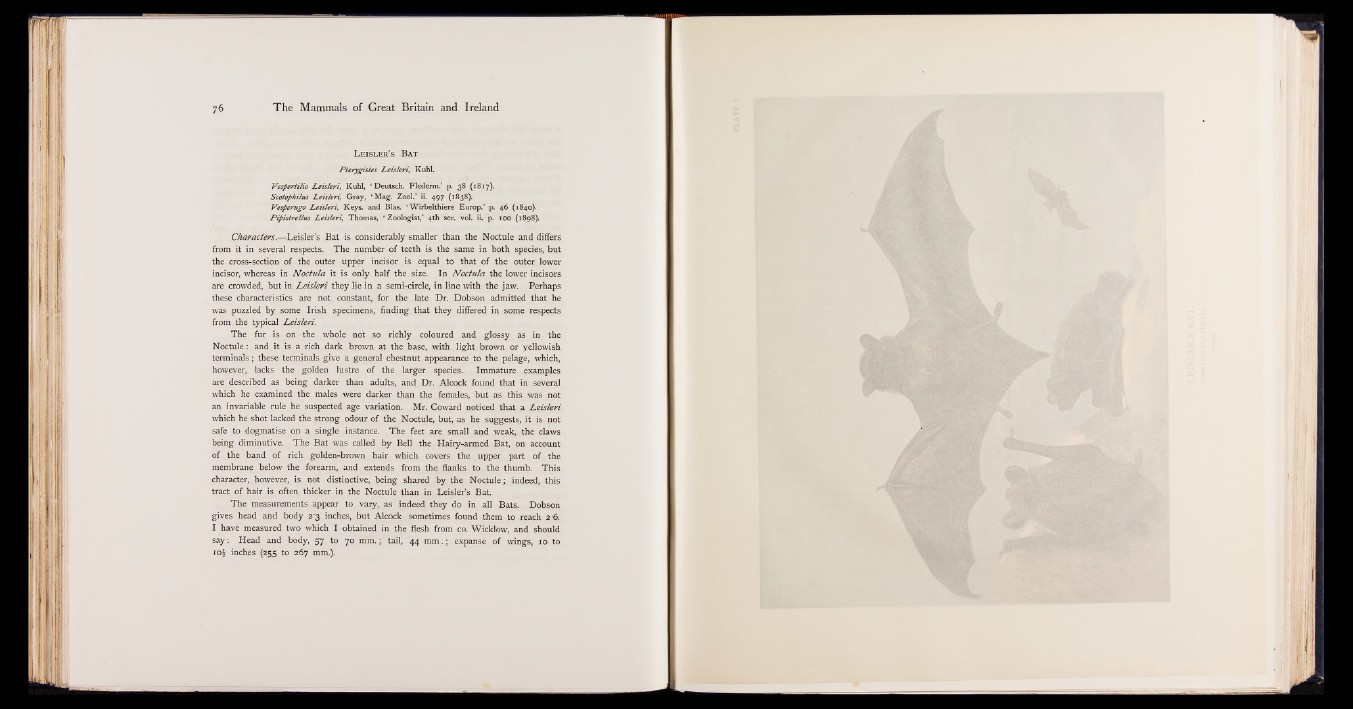
76 The Mammals of Great Britain and Ireland
L e is l e r ’s B a t
Pterygistes Leisleri, Kuhl.
Vespertilio Leisleri, Kuhl, ‘ Deutsch. Flederm.’ p. 38 (1817).
Scotophilus Leisleri, Gray, ‘ Mag. Zool.’ ii. 497 (1838).
Vesperugo Leisleri, Keys, and Bias. ' W irbelthiere Europ.’ p. 46 (1840).
Pipistrellus Leisleri, Thomas, ‘ Zoologist,’ 4th ser. vol. ii. p. 100 (1898).
Characters.— Leisler’s Bat is considerably smaller than the Noctule and differs
from it in several respects. The number of teeth is the same in both species, but
the cross-section of the outer upper incisor is equal to that of the outer lower
incisor, whereas in Noctula it is only half the size. In Noctula the lower incisors
are crowded, but in Leisleri they lie in a semi-circle, in line with the jaw. Perhaps
these characteristics are not constant, for the late Dr. Dobson admitted that he
was puzzled by some Irish specimens, finding that they differed in some respects
from the typical Leisleri.
The fur is on the whole not so richly coloured and glossy as in the
Noctule: and it is a rich dark brown at the base, with light brown or yellowish
terminals; these terminals give a general chestnut appearance to the pelage, which,
however, lacks the golden lustre of the larger species. Immature examples
are described as being darker than adults, and Dr. Alcock found that in several
which he examined the males were darker than the females, but as this was not
an invariable rule he suspected age variation. Mr. Coward noticed that a Leisleri
which he shot lacked the strong odour of the Noctule, but, as he suggests, it is not
safe to dogmatise on a single instance. The feet are small and weak, the claws
being diminutive. The Bat was called by Bell the Hairy-armed Bat, on account
of the band of rich golden-brown hair which covers the upper part of the
membrane below the forearm, and extends from the flanks to the thumb. This
character, however, is not distinctive, being shared by the Noctule ; indeed, this
tract of hair is often thicker in the Noctule than in Leisler’s Bat.
The measurements appear to vary, as indeed they do in all Bats. Dobson
gives head and body 23 inches, but Alcock sometimes found them to reach 2 6.
I havé measured two which I obtained in the flesh from co. Wicklow, and should
say: Head and body, 57 to 70 mm.; tail, 44 mm.; expanse of wings, 10 to
io£ inches (255 to 267 mm.).